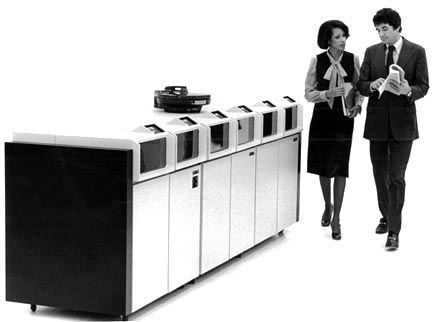
IBM 3340 Direct Access Storage Facility
- Models A2, B1 and B2 announced March 13, 1973
- Models B1 and C2 withdrawn December 20, 1983
- Models A2 & B2 withdrawn May 1, 1984
Following
a development effort that began in the summer of 1969, the IBM 3340
disk unit was introduced in March 1973 with an advanced disk technology
known as "Winchester."* The first 3340 shipments to customers began in November 1973.
The
3340 featured a smaller, lighter read/write head that could ride closer
to the disk surface -- on an air film 18 millionths of an inch thick --
with a load of less than 20 grams. The Winchester disk file's low-cost
head-slider structure made it feasible to use two heads per surface,
cutting the stroke length in half. The disks, the disk spindle and
bearings, the carriage and the head-arm assemblies were incorporated
into a removable sealed cartridge called the IBM 3348 Data Module. A
track density of 300 tracks per inch and an access time of 25
milliseconds were achieved.
The 3340 offered
the optional availability of fixed heads, which provided an average
access time of only five milliseconds. It had three types of data
modules: 35 megabytes, 70 megabytes, and 70 megabytes of which 0.5
megabyte were accessible with fixed heads.
Two-to-four 3340 drives could be attached to the IBM System/370 Model 115 processor -- which had been announced concurrently with the 3340 -- providing a storage capacity of up to 280 million bytes.
*
Some observers have noted that the 3340 was known as "Winchester"
because its development engineers called it a "30-30" (its two spindles
each had a disk capacity of 30 megabytes), the common name of a rifle
manufactured by the Winchester Company. Kenneth E. Haughton, who led
the 3340 development effort, is reported to have said: "If it's a
30-30, then it must be a Winchester." |